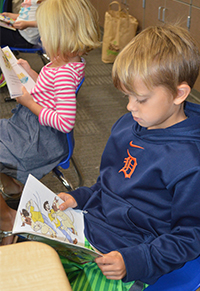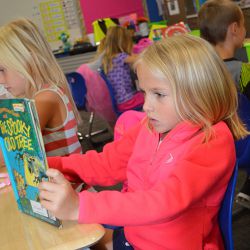West Middle School eighth-grade students Anja Whitehouse and Katie Townley are definitely what you would call “readers.” They finish one book to start another, immersing themselves in fantasy, historical fiction and sci/fi. Their favorite tomes are nestled amid folders and notebooks as they walk to class.
They give an honest perspective on reading itself: it’s funwhen they are indulging in a book they love, but it’s a chore when the words on the pages don’t hold their interest.
Lucky for them, Byron Center educators have discarded the notion that entire grade-levels should be reading certain books at the same time in a set trajectory that goes from See Spot Run in early elementary to The Great Gatsby in high school.

Instead, teachers tap into that simple philosophy Katie and Anja naturally know: students gain the most from reading what they love. A reading and writing program with a strong focus on instruction embedded in “choice” reading has now been implemented district-wide.
The objective: to develop lifelong readers.
“I don’t have to dread reading anymore,” said Anja, who recently finished reading The dystopian/romance The Selection Series, by Kiera Cass. Books she used to read in her spare time she now reads for school.
“In elementary, they would chose books for us,” added Katie. “Now we can read whatever we want.”
The district has adopted a system of teaching reading and writing using a workshop approach and has teachers studying through The Teachers College Reading and Writing Project, a method educators say helps students learn to love reading and writing while meeting all grade-level standards along the way. This approach is being used at Brown, Marshall, Countryside Elementary schools, Nickels Intermediate School and West Elementary School.

Trained By a Superstar
Eleven Byron Center teachers attended training this summer at Teachers College at Columbia University, in New York, and are now serving as instruction coaches for other district teachers. A private consultant from Teachers College is also working with the district.
At the training, teachers learned from leading literacy experts and children’s book authors, including Lucy Calkins, founding director of Teachers College Reading and Writing Project. Calkins works closely with inner-city schools in New York City, where the model has been adopted state-wide.
In practice, the workshop structure is the same for both subjects. Teachers lead 10-minute mini lessons, with students seated on the classroom carpet, to examine a piece of text and talk about an element of reading or writing such as theme, setting or plot. Students then discuss the topics with one another before breaking off to practice finding those elements in their own books.
“One of the premises is keeping your lessons mini and letting kids read with choice and write with choice,” said Kari Anama, executive director of Instructional Services for the district.

Identifying Different Needs
A big emphasis is also on one-on-one and small group “conferring,” when teachers discuss with students what they’ve read to gauge what each student is learning.
“That’s where you really zoom in on what the kids individually need,” said seventh-grade teacher Jamie Stevenson.
With each child moving at his or her own pace, it’s easier to help students at different levels progress, teachers said.
“I’m not teaching reading and writing,” said fourth-grade teacher Stacey Langdon. “I’m teaching the reader or the writer. I’m teaching them skills they are ready for, that they are prepared for at their level, on a small-group basis.”
The goal is to have every student at grade level or higher, Anama said.
“We’ve noticed since we started having a (consistent) system in place, all of our kindergartners are at grade level, including special ed students or English-language learners, and we hope to see that every year,” she said.
Langdon said she hopes students develop the lifelong skill of getting the most out of reading.
“We want students to be thinkers when they are readers. We want them to love reading and have a passion for reading, and we want them thinking all the time while they are reading,” she said.
Eighth-grade student Noah Lein thinks it’s working. He said he sees himself becoming a better reader.
“You used to be forced into genres you didn’t like, so you couldn’t really grow in reading if you didn’t like the books,” he said. “Now I’m growing as a reader a lot more than in elementary school.”
CONNECT









